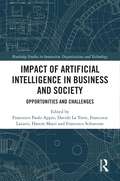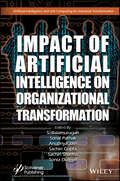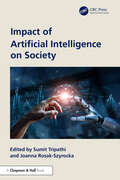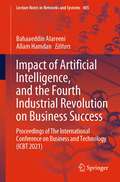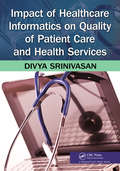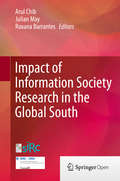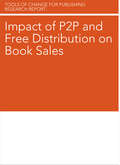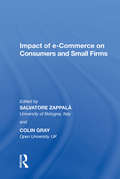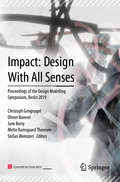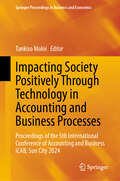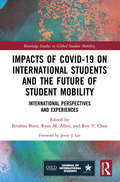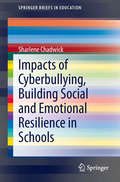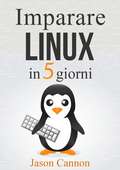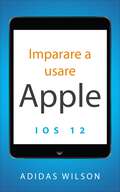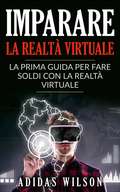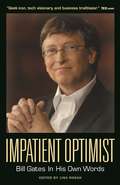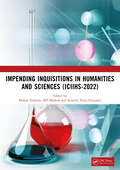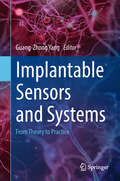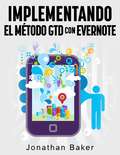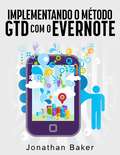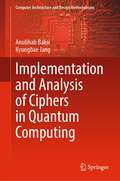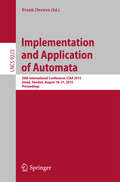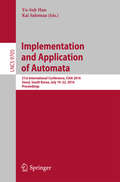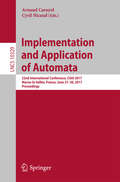- Table View
- List View
Impact of Artificial Intelligence in Business and Society: Opportunities and Challenges (Routledge Studies in Innovation, Organizations and Technology)
by Francesco Schiavone Hatem Masri Francesca Lazzeri Francesco Paolo Appio Davide La TorreBelonging to the realm of intelligent technologies, it is increasingly accepted that artificial intelligence (AI) has evolved from being merely a development standpoint in computer science. Indeed, recent reports and academic publications show that we are clearly on the path toward pervasive AI in both business and society. Organizations must adopt AI to maintain a competitive advantage and explore opportunities for unprecedented innovation. This book focuses on understanding the wide range of opportunities as well as the spectrum of challenges AI brings in different business contexts and society at large. The book highlights novel and high-quality research in data science and business analytics and examines the current and future impact of AI in business and society. The authors bridge the gap between business and technical perspectives and demonstrate the potential (and actual) impact on society. Embracing applied, qualitative, and quantitative research as well as field experiments and data analysis, the book covers a broad range of topics including but not limited to human-centered AI, product and process innovation, corporate governance, AI and ethics, organizational performance, and entrepreneurship. This comprehensive book will be a valuable resource for researchers, academics, and postgraduate students across AI, technology and innovation management, and a wide range of business disciplines.
Impact of Artificial Intelligence on Organizational Transformation (Artificial Intelligence and Soft Computing for Industrial Transformation)
by S. Balamurugan Anupriya Jain Sachin Sharma Sonia Duggal Sachin Gupta Sonal PathakIMPACT OF ARTIFICIAL INTELLIGENCE ON ORGANIZATIONAL TRANSFORMATION Discusses the impact of AI on organizational transformation which is a mix of computational techniques and management practices, with in-depth analysis about the role of automation & data management, and strategic management in relation to human capital, procurement & production, finance, and marketing. The impact of AI in restructuring organizational processes is a combination of management practices and computational technology. This book covers the areas like artificial intelligence & its impact on professions, as well as machine learning algorithms and technologies. The context of applications of AI in business process innovation primarily includes new business models, AI readiness and maturity at the organizational, technological, financial, and cultural levels. The book has extensive details on machine learning and the applications such as robotics, blockchain, Internet of Things. Also discussed are the influence of AI on financial strategies and policies, human skills & values, procurement innovation, production innovation, AI in marketing & sales platforms. Audience Readers include those working in artificial intelligence, business management studies, technology engineers, senior executives, and human resource managers in all types of business.
Impact of Artificial Intelligence on Society
by Joanna Rosak-Szyrocka Sumit TripathiThe book presents a comprehensive and interdisciplinary exploration of the impact of AI on various sectors of society to foster a greater understanding of the opportunities and challenges presented by this transformative technology. It explores the impact AI has had on varied sectors of society, including healthcare, education, the workplace, and the economy. It provides a holistic view of this fast-growing technology by critical study of the possible benefits and drawbacks linked with the application of AI in many industries. The book also examines the ethical, social, and economic implications of AI and the potential risks and challenges associated with its use. Focuses on the future influence of AI, providing insights into how it could disrupt several industries and change the way we live, work, and connect with one another Explores how AI can be used to tackle global issues such as climate change, food security, and public health concerns Offers case studies and specific examples of how artificial intelligence is being employed in many industries, covering both successes and failures Investigates cutting-edge technology breakthroughs in AI and how they can be used to improve efficiency, productivity, and performance across multiple industries Understands the limitations and potential biases of artificial intelligence, as well as the significance of human monitoring and accountability The book is intended for researchers, practitioners, policymakers, and students who are interested in understanding the nature and role of AI with regard to different sectors of society.
Impact of Artificial Intelligence, and the Fourth Industrial Revolution on Business Success: Proceedings of The International Conference on Business and Technology (ICBT 2021) (Lecture Notes in Networks and Systems #485)
by Allam Hamdan Bahaaeddin AlareeniThis book constitutes the refereed proceedings of the International Conference on Business and Technology (ICBT2021) organized by EuroMid Academy of Business & Technology (EMABT), held in Istanbul, between 06–07 November 2021. In response to the call for papers for ICBT2021, 485 papers were submitted for presentation and inclusion in the proceedings of the conference. After a careful blind refereeing process, 292 papers were selected for inclusion in the conference proceedings from forty countries. Each of these chapters was evaluated through an editorial board, and each chapter was passed through a double-blind peer-review process.The book highlights a range of topics in the fields of technology, entrepreneurship, business administration, accounting, and economics that can contribute to business development in countries, such as learning machines, artificial intelligence, big data, deep learning, game-based learning, management information system, accounting information system, knowledge management, entrepreneurship, and social enterprise, corporate social responsibility and sustainability, business policy and strategic management, international management and organizations, organizational behavior and HRM, operations management and logistics research, controversial issues in management and organizations, turnaround, corporate entrepreneurship, innovation, legal issues, business ethics, and firm gerial accounting and firm financial affairs, non-traditional research, and creative methodologies.These proceedings are reflecting quality research contributing theoretical and practical implications, for those who are wise to apply the technology within any business sector. It is our hope that the contribution of this book proceedings will be of the academic level which even decision-makers in the various economic and executive-level will get to appreciate.
Impact of Healthcare Informatics on Quality of Patient Care and Health Services
by Divya Srinivasan SridharRecent healthcare reform and its provisions have pushed health information technology (HIT) into the forefront. Higher life expectancies, fewer medical errors, lower costs, and improved transparency are all possible through HIT.Taking an integrated approach, Impact of Healthcare Informatics on Quality of Patient Care and Health Services examines th
Impact of Information Society Research in the Global South
by Julian May Arul Chib Roxana BarrantesThe second volume in the SIRCA book series investigates the impact of information society initiatives by extending the boundaries of academic research into the realm of practice. Global in scope, it includes contributions and research projects from Asia, Africa and Latin America. The international scholarly community has taken a variety of approaches to question the impact of information society initiatives on populations in the Global South. This book addresses two aspects-- Impact of research: How is the research on ICTs in the Global South playing a role in creating an information society? (e. g. policy formulation, media coverage, implementation in practice) and Research on impact: What is the evidence for the impact of ICTs on society? (i. e. the objectives of socio-economic development). This volume brings together a multiplicity of voices and approaches from social scientific research to produce an engaging volume for a variety of stakeholders including academics, researchers, practitioners, policy-makers and those in the business and civil sectors of society.
Impact of P2P and Free Distribution on Book Sales
by Brian O'LearyBook publishers have long used free content as part of their marketing and selling efforts, with the vast majority of free content distributed in printed form. Digital distribution of free material, either intentional or via unauthorized availability through peer-to-peer sites and other Web outlets, offers a fast and expansive connection to consumers, but content can also be copied and disseminated without publishers' control. Some publishers are torn between the efficiencies digital distribution provides and concerns over piracy and print-sale cannibalization. This research report is part of an ongoing effort by O'Reilly Media Inc. and Random House to test assumptions about free distribution, P2P availability and their potential impact on book sales.
Impact of e-Commerce on Consumers and Small Firms
by Salvatore ZappalaThe change from old to new technologies has fundamentally changed the relationship between the consumer and the firm. This book is at the frontier of behavioural research into how these new commercial realities are borne out in practice, examining the adoption of e-commerce by small firms and the transactional phenomenon that entails access to the Internet. In analyzing the process of e-commerce adoption and why e-commerce actors behave as they do, its coverage includes the adoption of information and communication technologies (ICT) by small firms; the use of ICT applications to support marketing and sales transactions; and the factors that influence consumers' online purchasing decisions.
Impact: Proceedings of the Design Modelling Symposium, Berlin 2019
by Christoph Gengnagel Jane Burry Mette Ramsgaard Thomsen Stefan Weinzierl Olivier BaverelThis book reflects and expands on the current trend in the building industry to understand, simulate and ultimately design buildings by taking into consideration the interlinked elements and forces that act on them. Shifting away from the traditional focus, which was exclusively on building tasks, this approach presents new challenges in all areas of the industry, from material and structural to the urban scale. The book presents contributions including research papers and case studies, providing a comprehensive overview of the field as well as perspectives from related disciplines, such as computer science. The chapter authors were invited speakers at the 7th Symposium “Impact: Design With All Senses”, which took place at the University of the Arts in Berlin in September 2019.
Impacting Society Positively Through Technology in Accounting and Business Processes: Proceedings of the 5th International Conference of Accounting and Business iCAB, Sun City 2024 (Springer Proceedings in Business and Economics)
by Tankiso MoloiThis conference volume discusses the findings of the iCAB 2024 conference that took place in Sun City, South Africa, on June 27-28 2024. The University of Johannesburg hosted the iCAB 2024 conference with the aim to bring together researchers from different Accounting and Business Management fields to share ideas and discuss how new disruptive technological developments are impacting the field of accounting. The conference was sponsored by the Association of International Certified Professional Accountants AICPA & CIMA.
Impacts of COVID-19 on International Students and the Future of Student Mobility: International Perspectives and Experiences (Routledge Studies in Global Student Mobility)
by Krishna Bista Roy Y. Chan Ryan M. AllenThis volume uses case studies and students' lived experiences to document the impacts of coronavirus (COVID-19) on international students and explore future challenges and opportunities for student mobility within higher education. Responding to the growing need for new insights and perspectives to improve higher education policy and practice in the era of COVID-19, this text analyses the changing roles and responsibilities of institutions and international education leaders post-2020. Initial chapters highlight key issues for students that have arisen as a result of the global health crisis such as learning, well-being, and the changed emotional, legal, and financial implications of study abroad. Subsequent chapters confront potential longer-term implications of students’ experiences during COVID-19, and provide critical reflection on internationalization and the opportunities that COVID-19 has presented for tertiary education systems around the world to learn from one another. This timely volume will benefit researchers, academics, and educators with an interest in online teaching and e-learning, curriculum design, and more specifically those involved with international and comparative education. Those involved with educational policy and practice, specifically related to pandemic education, will also benefit from this volume.
Impacts of Cyberbullying, Building Social and Emotional Resilience in Schools
by Sharlene ChadwickThis volume explores cyberbullying and its impact on young people in schools in detail. It investigates social and emotional resilience and wellbeing in relation to developing protective factors against the impacts of cyberbullying and contains a range of perspectives to deal positively with cyberbullying as well as a summary of international research. Cyberbullying occurs when any means of technology is used to repeatedly and deliberately engage in bullying behaviours with the intent to cause harm to others. Although anyone can be affected, young people who are also being bullied offline are more likely to be the target of cyberbullying. Forms of cyberbullying include: * abusive texts and emails * posting messages or images * imitating and excluding others online * inappropriate image tagging. Cyberbullying differs from face-to-face bullying. * a sense of anonymity for those who bully * can occur 24/7 and is invasive * can have a large audience * difficult to delete comments and images.
Imparare Linux in 5 giorni
by Jason Cannon Simona LeggeroSe volete imparare come usare Linux ed avanzare nella vostra carriera, ma siete pressati da tempo, leggete. Come fondatore della Linux Training Academy ed istruttore in diversi corsi, ho avuto la fortuna di aiutare centinaia di persone a perfezionare le loro conoscenze di Linux. Interagendo con alcune persone che hanno appena iniziato con il sistema operativo Linux, ho avuto l'intuizione impagabile dei particolari sforzi e sfide che le persone affrontano a questo livello. Una delle più grandi sfide per le persone interessate ad imparare i dentro e i fuori di Linux è semplicemente una mancanza di tempo. Quando state lavorando con risorse limitate e di ottimo valore, volete essere sicuri di fare di più. La più grande sfida per i principianti di Linux è sapere da dove incominciare. Ci sono molte informazioni disponibili che permettono di decidere come focalizzare la vostra attenzione, per prima cosa, il grande ostacolo è quello di mantenere le persone già dall'inizio. La cosa peggiore è iniziare il percorso di studio solo per scoprire molti concetti, comandi e sfumature che non sono spiegate. Questo tipo di esperienza è frustante e vi lascia con più domande che risposte. Ecco perché ho scritto questo libro. Non ho solo sintetizzato il materiale più importante in cinque capitoli, ognuna disegnata per essere studiata in un giorno, ma ho anche strutturato il contenuto in modo logico e sistematico. Questo metodo vi assicurerà di risparmiare tempo studiando prima gli aspetti fondamentali di Linux e successivamente costruire le fondamenta giorno dopo giorno. In Imparare Linux in 5 giorni, imparerete i concetti e comandi più importanti, e sarete guidati passo dopo passo in esempi pratici e di vita reale. I nuovi concetti, comandi o gerghi in cui ci imbatteremo sono spiegati in un linguaggio semplice rendendoli di facile comprensione. Ecco qui cosa imparerete leggendo Imparare Linux in 5 giorni. Come accedere al s
Imparare a usare Apple iOS 12
by Adidas WilsonApple ha svelato la nuova versione di iOS, iOS 12. La versione è disponibile gratuitamente sia per iPad che per iPhone dalla fine del 2018. Di seguito sono riportate alcune delle migliori funzionalità che puoi sperimentare con la nuova versione. Apple ha confermato che raddoppierà le prestazioni per aumentare la velocità e la reattività di iPad e iPhone. Hai già impostato il tuo iPad ma non sai quale passo fare dopo? I nuovi utenti di iPad di solito non sanno come trovare e installare buone app, organizzarle o eliminarle. Anche se conosci le basi, potresti aver bisogno di alcuni trucchi per ottenere il massimo dal tuo iPad. Gran parte della navigazione viene eseguita tramite gesti tattili come toccare un'app per avviarla o far scorrere il dito.
Imparare la realtà virtuale: la prima guida per fare soldi con la realtà virtuale.
by Adidas Wilson Mario RutiglianoDa anni la gente aspettava il decollo della realtà virtuale ed è sempre rimasta delusa, questo fino a poco tempo fa. In vista c’è un futuro promettente per la realtà virtuale, ma gli investitori dovrebbero essere a conoscenza di molte cose prima di investire; come ad esempio, quali sono i rischi, quanto grande sarà il mercato, perché questa strategia dovrebbe essere giocata a lungo termine e chi sono i clienti chiave.
Impatient Optimist: Bill Gates in His Own Words
by Lisa RogakBill Gates, the founder and former CEO of Microsoft, has been a revered, and occasionally controversial, worldwide business icon for more than three decades.Recognized by most as an ingenious visionary, and painted by some as a tyrannical, less-than-scrupulous empire builder, Gates has had an unignorable impact on the growth of digital technology in daily life over the past 30 years. Even his sharpest critics have to acknowledge the obvious: Gates helped spearhead one of the greatest revolutions in modern history by seizing on the importance of software to the rise of the personal computer, along the way turning an arcane, specialized technology into a commonplace tool for the office and home.Gates has long been ranked as one of the world's wealthiest men--which gave him a name recognition far greater than that of most CEOs--and businesspeople of all stripes have looked to him as a role model, using his words and business strategies to help create, inspire, and grow their own companies. After he stopped running Microsoft's day-to-day operations in 2008 to devote himself full-time to the Bill & Melinda Gates Foundation, a kinder, gentler Gates began to emerge. As a result, people actively involved in the philanthropic world, whether in professional, part-time, or personal capacities, began to develop a new appreciation for the man.Bill Gates's second act is no less compelling than his first. And whether you're interested in his personal life or looking for inspiration to drive you forward in your own business endeavors, Impatient Optimist: Bill Gates in His Own Words has much to offer. As the tech giants who distinguished the turn of the 21st century shape public life in ways that outstrip the efforts of the previous century's titans of industry, we look to figures like Gates for inspiration as one of America's greatest business icons. This book will surely feed the world's curiosity about one of the most important leaders of the digital age.
Impending Inquisitions in Humanities and Sciences
by Mohan Varkolu Kranthi Priya Oruganti M P MalleshIn an era of increasing specialization, the need for cross-disciplinary dialogue demands an integrated approach that transcends the artificial boundaries between disciplines. "Impending Inquisitions in Humanities and Sciences" presents a groundbreaking tapestry of cutting-edge research across the spectrum of humanities and sciences. This volume presents a meticulously curated selection of research papers presented at the conference, a forum where scholars from diverse fields – English, Mathematics, Physics, and Chemistry – converged to engage in rigorous dialogue and push the boundaries of knowledge. From the nuanced interpretations of literary texts to the elegant formulations of mathematical models, from the awe-inspiring revelations of physics to the meticulous experiments of chemistry, each contribution challenges assumptions and provokes fresh perspectives. This collection serves as a valuable resource for scholars, students, and academic fraternity with an insatiable curiosity about the world around us.
Implantable Sensors and Systems
by Guang-Zhong YangImplantable sensing, whether used for transient or long-term monitoring of in vivo physiological, bio-electrical, bio-chemical and metabolic changes, is a rapidly advancing field of research and development. Underpinned by increasingly small, smart and energy efficient designs, they become an integral part of surgical prostheses or implants for both acute and chronic conditions, supporting optimised, context aware sensing, feedback, or stimulation with due consideration of system level impact.From sensor design, fabrication, on-node processing with application specific integrated circuits, to power optimisation, wireless data paths and security, this book provides a detailed explanation of both the theories and practical considerations of developing novel implantable sensors. Other topics covered by the book include sensor embodiment and flexible electronics, implantable optical sensors and power harvesting. Implantable Sensors and Systems – from Theory to Practice is an important reference for those working in the field of medical devices. The structure of the book is carefully prepared so that it can also be used as an introductory reference for those about to enter into this exciting research and developing field.
Implementación de Calidad de Servicio basada en ISO/IEC 20000
by Michael KunasISO/IEC 20000 es un estándar internacional importante para los proveedores de servicios de TI. La implementación y certificación según esta norma mejorará sus procesos y prácticas de negocio, y dará a sus clientes la confianza de que su empresa sea eficiente y fiable. Los clientes volverán porque saben por experiencia que su servicio es insuperable. Los clientes potenciales buscarán a los proveedores con la norma ISO/IEC 20000 por la tranquilidad que proporciona. Este libro le guiará a través de la implementación y certificación, lo que le permitirá agilizar sus procesos de gestión y ofrecer a sus clientes servicios de primera clase con precios competitivos. Esta guía de gestión 'paso a paso' beneficiará a todos los que tengan un papel en el proceso de implementación y certificación. Escrita para empresas de cualquier tamaño y de cualquier lugar, le da un desglose claro y detallado de la edición de 2011 de la norma y examina su relación con otras normas relacionadas, como ITIL® y COBIT®. Ofrece una gran cantidad de consejos prácticos y recomendaciones sobre cómo prepararse para la auditoría y la puesta en práctica, por lo que su viaje a la certificación será lo más fácil posible. Michael Kunas es auditor jefe de ISO/IEC 20000 y consultor ITSM y tiene más de 15 años de experiencia en todas las áreas de ciencias de la computación. Ha viajado por todo el mundo como consultor, docente y conferenciante sobre la norma ISO/IEC 20000 y los marcos y métodos relacionados con esta norma. También es coautor de un libro sobre un software de matemáticas y ha escrito artículos sobre la gestión de servicios TI, ITIL e ISO/IEC 20000 en las revistas españolas de informática, tales como Data TI y Computerworld. Una guía práctica que dará a su empresa la 'vanguardia' en la calidad del servicio.
Implementando el método GTD con Evernote
by Jonathan Baker Maria Jose BalbontinAprende cómo sacarle el máximo provecho al método GTD y a Evernote. Getting Things Done®, o GTD®, es un método de gestión de tiempo creado por el consultor de productividad David Allen. GTD es una de las técnicas más efectivas y populares que puedes usar para tomar las riendas de tu lista de tareas e incrementar tu productividad. El método GTD no sólo te ayuda a completar las tareas y proyectos inmediatos, sino que también te ayuda a avanzar hacia las metas más grandes en tu vida. Evernote® es un programa que originalmente fue creado para tomar y archivar notas. Estas notas pueden ser de texto, páginas web, mensajes de voz, fotos, y más. Evernote es estupendo para guardar todo tipo de información, y te hace fácil organizar y encontrar tu información. Con los consejos que ofrece este libro podrás combinar Evernote y GTD para crear un poderoso sistema para mejorar tu productividad. Usar el método GTD con Evernote te permitirá organizar tu vida personal y profesional en formato electrónico. Ya que Evernote está disponible como aplicación web y en dispositivos móviles, siempre puedes tener acceso a tus tareas, proyectos, metas y notas cuando y donde las necesites.
Implementando o método GTD com o Evernote
by Janaina De Oliveira Ribeiro Jonathan BakerAprenda a tirar o maior proveito do GTD com o Evernote. Getting Things Done®, ou GTD®, é um método de gerenciamento de tempo criada pelo consultor de produtividade David Allen. GTD é um das técnicas mais populares e eficazes que você pode utilizar para manter a sua lista de afazeres sob controle e aumentar sua produtividade. Além de auxiliar a completar as tarefas e projetos à mão, O GTD também lhe ajudará a caminhar em direção às metas maiores em sua vida. O Evernote® é um software que foi originalmente desenvolvido para fazer e arquivar anotações. Essas anotações podem ser texto, páginas da Web, memorandos de voz, quadros, e mais. O Evernote é ótimo para armazenar todos os tipos de informações, tornando fácil a organização e o acesso a seus dados. Com um pouco do know-how fornecido nesse livro, você poderá casar o Evernote com o GTD para criar uma poderosa máquina de aumento da produtividade. O uso do Evernote com o GTD permitirão que você organize seu trabalho e vida pessoal no formato eletrônico. Desde que o Evernote está disponível como um aplicativo da web e em dispositivos móveis, você sempre poderá ter acesso a suas tarefas, projetos, metas e notas sempre que e onde quer que os necessitar.
Implementation and Analysis of Ciphers in Quantum Computing (Computer Architecture and Design Methodologies)
by Anubhab Baksi Kyungbae JangThis book deals with the upcoming threat that may be posed by quantum computers on modern-day security standards, particularly those involving symmetric key ciphers. Considering the progress in the field of quantum computing over the past few years, there is an ever-growing need to analyze the ciphers that are being employed in ensuring security. The symmetric key ciphers are generally considered safe against quantum computers, though one must consider the possible impact due to Grover's search algorithm (that reduces the security claim to the square root bound of what is expected against a classical computer). This book consolidates all the major research works in one place and presents it with adequate clarity, making the subject matter easy to understand for seasoned researchers and students alike. It covers the prerequisite information, new research works (including some of the state of the art), thought-provoking problems for further research, and all the relevant source codes. This book is interesting to engineers, researchers, and students who work/study in the field of cryptography.
Implementation and Application of Automata
by Frank DrewesThis book constitutes the refereed proceedings of the 20th International Conference on Implementation and Application of Automata, CIAA 2015, held in held in Umeå, Sweden, in August 2015. The 22 revised full papers presented together with 4 invited papers and 2 toool demonstration papers were carefully reviewed and selected from 49 submissions. The papers cover all aspects of cover automata, counter automata, decision algorithms on automata, descriptional complexity, expressive power of automata, homing sequences, jumping finite automata, multi-dimensional languages, parsing and pattern matching, quantum automata, realtime pushdown automata, random generation of automata, regular expressions, security issues, sensors in automata, transducers, transformation of automata, and weighted automata.
Implementation and Application of Automata
by Yo-Sub Han Kai SalomaaThis book constitutes the refereed proceedings of the 21st InternationalConference on Implementation and Application of Automata, CIAA 2016, held in Seoul, South Korea, in July 2016. The 26 revised full papers presented were carefully reviewed and selected from49 submissions. The papers cover a wide range of topics including characterizations of automata, computing distances between strings and languages, implementations ofautomata and experiments, enhanced regular expressions, and complexity analysis.
Implementation and Application of Automata: 22nd International Conference, CIAA 2017, Marne-la-Vallée, France, June 27-30, 2017, Proceedings (Lecture Notes in Computer Science #10329)
by Arnaud Carayol and Cyril NicaudThis book constitutes the refereed proceedings of the 22nd International Conference on Implementation and Application of Automata, CIAA 2017,held in Marne-la-Vallée, France, in June 2017. The 17 revised full papers presented were carefully reviewed and selected from 31 submissions. The topics of the presented papers include state complexity of automata; implementations of automata and experiments; enhanced regular expressions; and complexity analysis.
